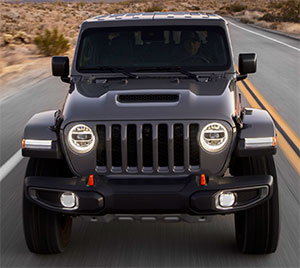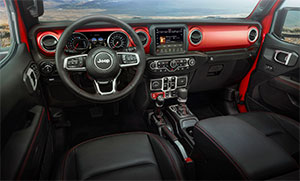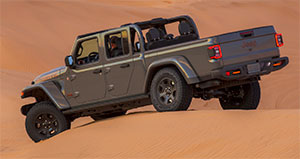2020 Jeep Gladiator Mojave
Up until now, if you wanted the best of what Jeep has to offer for the Wrangler and off-road performance, you went with the Rubicon. And things started out the same for Jeep’s new Gladiator pickup truck as well, but they didn’t stay that way for very long. Enter the new Jeep Gladiator Mojave. So let’s find out what this desert sled has to offer the Jeep faithful.
You may have gathered from the name already, that the 2020 Jeep Gladiator Mojave is something different. Whereas the Rubicon is built to withstand the abuse of bouncing off boulders and climbing the rock ledges of the Rubicon trail; the Mojave is aimed for wide open desert running, in a fashion similar to Ford’s SVT Raptor.
The short wheelbase Wrangler was never truly appropriate for that mission, but the Gladiator’s 40-inch longer wheelbase is just about perfect; and this Mojave was in FCA’s original plans for the Gladiator from the beginning.
Equipping it for that mission, the Mojave gets a 1-inch lift; with springs that are both taller and softer, to provide additional travel and smoother movement. The frame and steering hardware are reinforced to withstand repeated hard landings, axles are beefed up, while anti-roll bars are actually softer. Finally, skid plating underneath of it all, has been reconfigured to protect all of the important stuff.
 Just like Ford, Jeep turned to suspension specialist Fox for remote reservoir shocks with progressive damping; but went one step further, adding hydraulic bump stops as well, which makes shattering hard parts less likely when bottoming out the suspension.
Just like Ford, Jeep turned to suspension specialist Fox for remote reservoir shocks with progressive damping; but went one step further, adding hydraulic bump stops as well, which makes shattering hard parts less likely when bottoming out the suspension.
Less low speed work means no need for the Rubicon’s 4:1 transfer case; so the Mojave sticks with the standard 2.72, as well as the open front differential.
33-inch tires, with either all terrain or mud terrain tread patterns, are mounted on 17-inch wheels with more offset than the Rubicon’s, to widen the track and lend a bit more high-speed stability.
Mojave graphics are applied to the unique hood, and it’s more than just a new name; as it turns out, Jeep engineers did indeed spend plenty of time in the Mojave desert developing this midsize pickup.
Finishing it all off, is a first ever “Desert Rated” badge, replacing the traditional “Trail Rated” one.
It’s all been well-tuned to work together and keep street drivability intact. Ride quality is actually a little plusher due to the softer suspension, though like many Gladiators, it’s a “keep both hands on the wheel” affair, as it is prone to wander. And, it’s easy to forget how big this Gladiator is, as it still feels very nimble, light on its feet, and easy to whip in and out of parking spots.
 Updates to the inside are minimal, but mostly functional, not just for show; in addition to unique stitching accents, front seats have much more aggressive bolstering for holding you in place, and there’s a “competition-inspired” steering wheel.
Updates to the inside are minimal, but mostly functional, not just for show; in addition to unique stitching accents, front seats have much more aggressive bolstering for holding you in place, and there’s a “competition-inspired” steering wheel.
And just as a reminder, the Gladiator is still the only pickup on the market that allows you to drive around legally without a roof or doors in place.
Same 285-horsepower 3.6-liter V6 engine with 260 lb-ft. of torque, as the rest of the Gladiator lineup. 6-speed manual transmission is standard, with 8-speed auto available.
Kept in rear-wheel-drive, there’s enough power to spin those 33s up a little off the line, but still get away quickly. The 3.6 is not the torquiest of engines, but feels plenty strong once it winds up a bit. We hit 60 in 8.8-seconds.
Shifts from the automatic are smooth and fairly quick, taking us to the end of the ¼-mile in 16.7-seconds at 85 miles-per-hour; as speed builds down the track, more and more steering inputs are required to keep everything pointed straight.
 Plenty of roll through the cones, but as you’d expect, it’s very easy to control; the traction control system seems to stay in the background. Steering has a nice weight to it, but there’s definitely a sense of disconnect between you and what’s going on way down at road level.
Plenty of roll through the cones, but as you’d expect, it’s very easy to control; the traction control system seems to stay in the background. Steering has a nice weight to it, but there’s definitely a sense of disconnect between you and what’s going on way down at road level.
Government Fuel Economy Ratings are 17-City, 22-Highway, and 19-Combined, so our average of 19.1 miles-per-gallon of Regular was right on. Not surprisingly the Energy Impact Score is well worse than average, at 17.3-barrels of yearly oil use, with 7.7 tons of CO2 emissions.
Considering a base Gladiator Sport pickup starts at $37,040, the step up to the Mojave takes a long stride for the checkbook to $45,370; but that’s actually the same as the Rubicon, and still not the priciest Gladiator you can buy. Plus, if you’re looking to wander far off the beaten path and survive the kind of abuse this truck is able to, that’s what it takes.
Now, you don’t have to venture way off into the desert, or even a beach, nor drive around at wide-open-throttle to enjoy this 2020 Jeep Gladiator Mojave. Yes, it does take a licking and keeps on ticking, but I think we can all agree, regardless of environment, this new Gladiator with a mission, is one cool pickup.
Specifications
- Engine: 3.6 liter
- Horsepower: 285
- Torque: 260 lb-ft.
- 0-60 mph: 8.8 seconds
- 1/4 mile: 16.7 seconds at 85 mph
- EPA: 17 mpg city / 22 mpg highway
- Energy Impact: 17.3 barrels of oil/yr
- CO2 Emissions: 7.7 tons/yr






